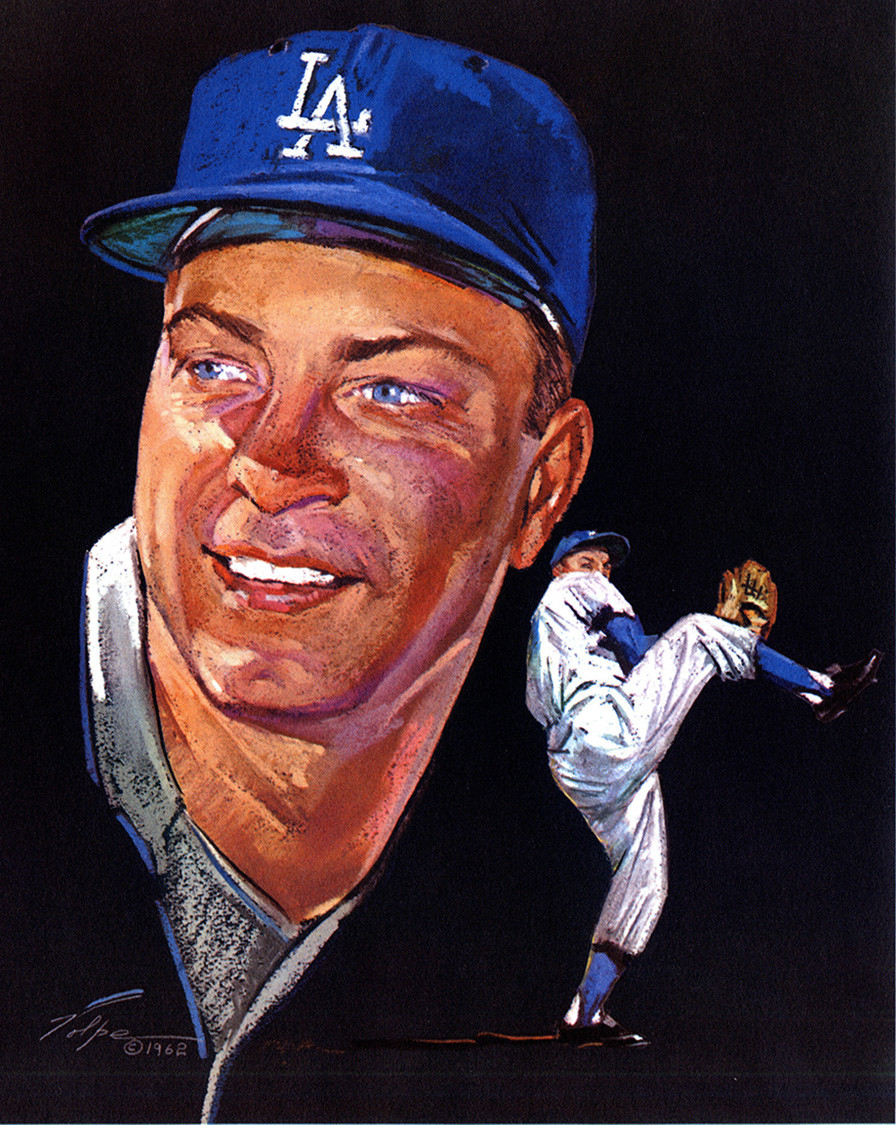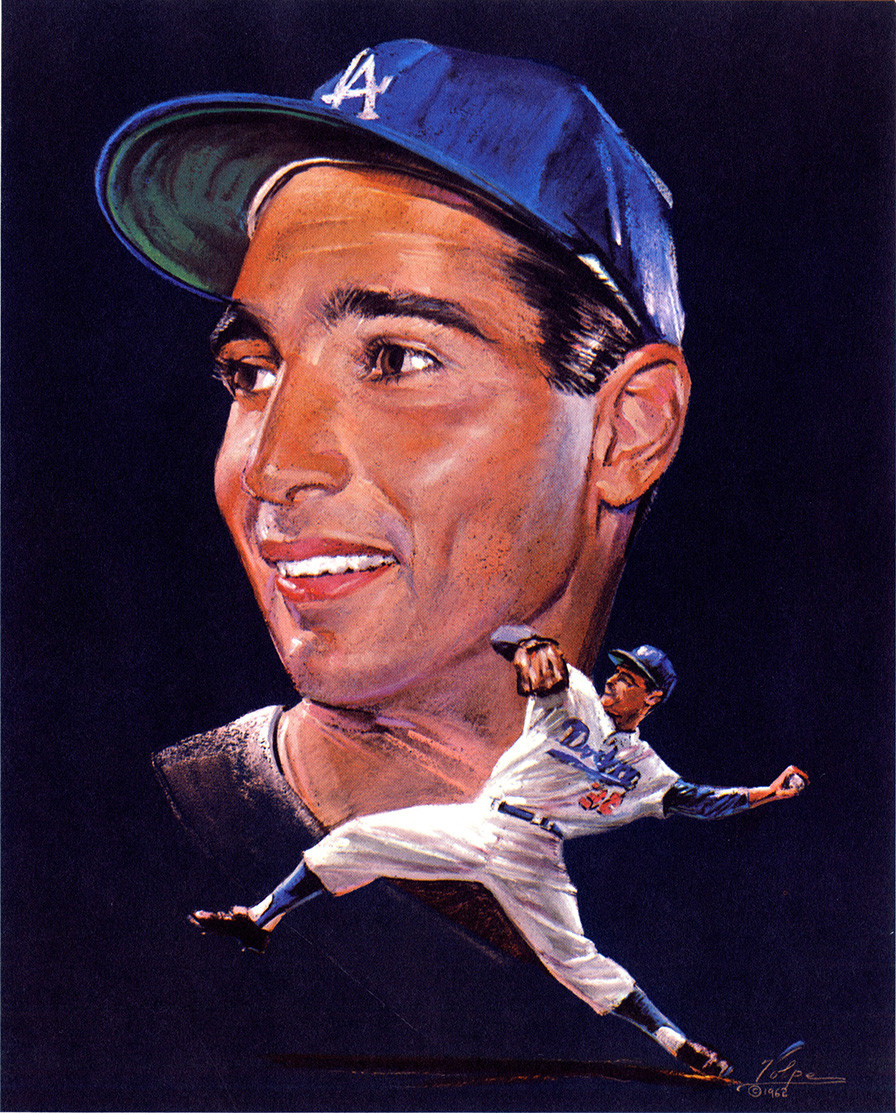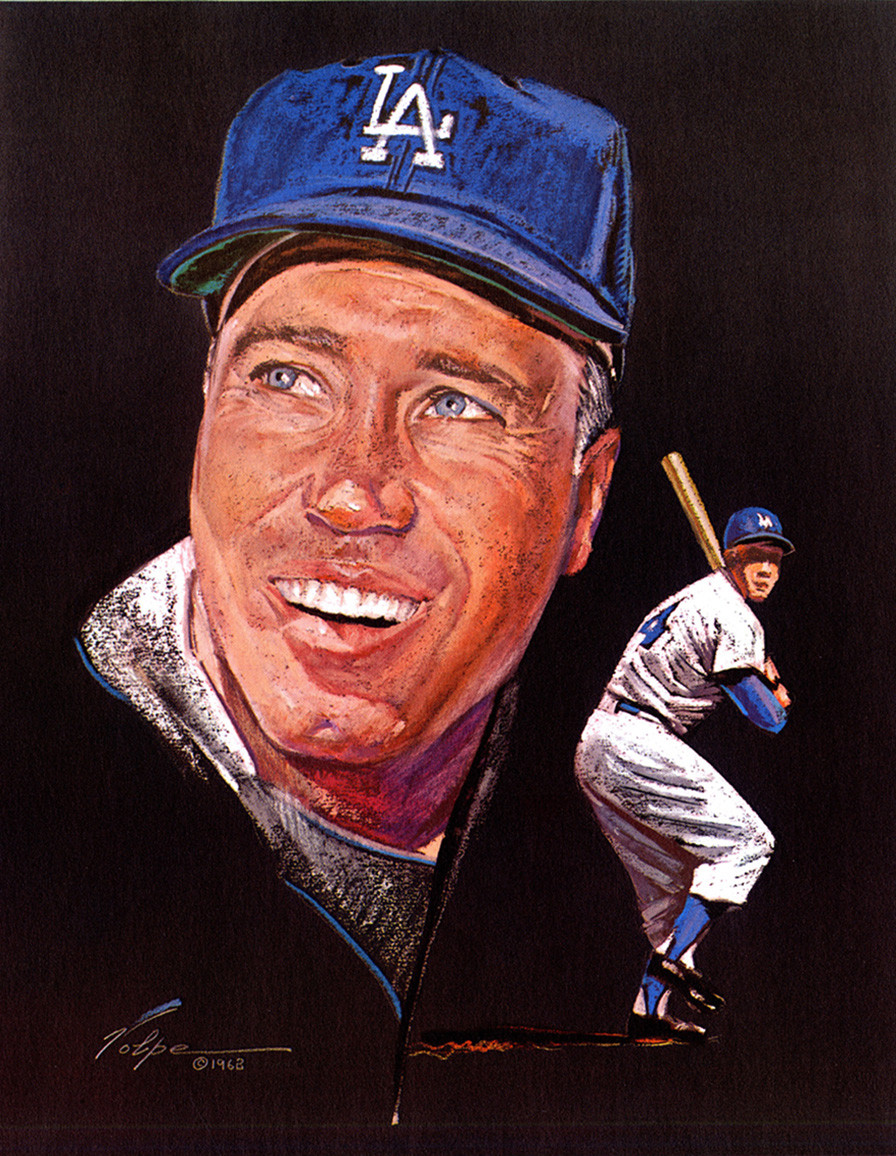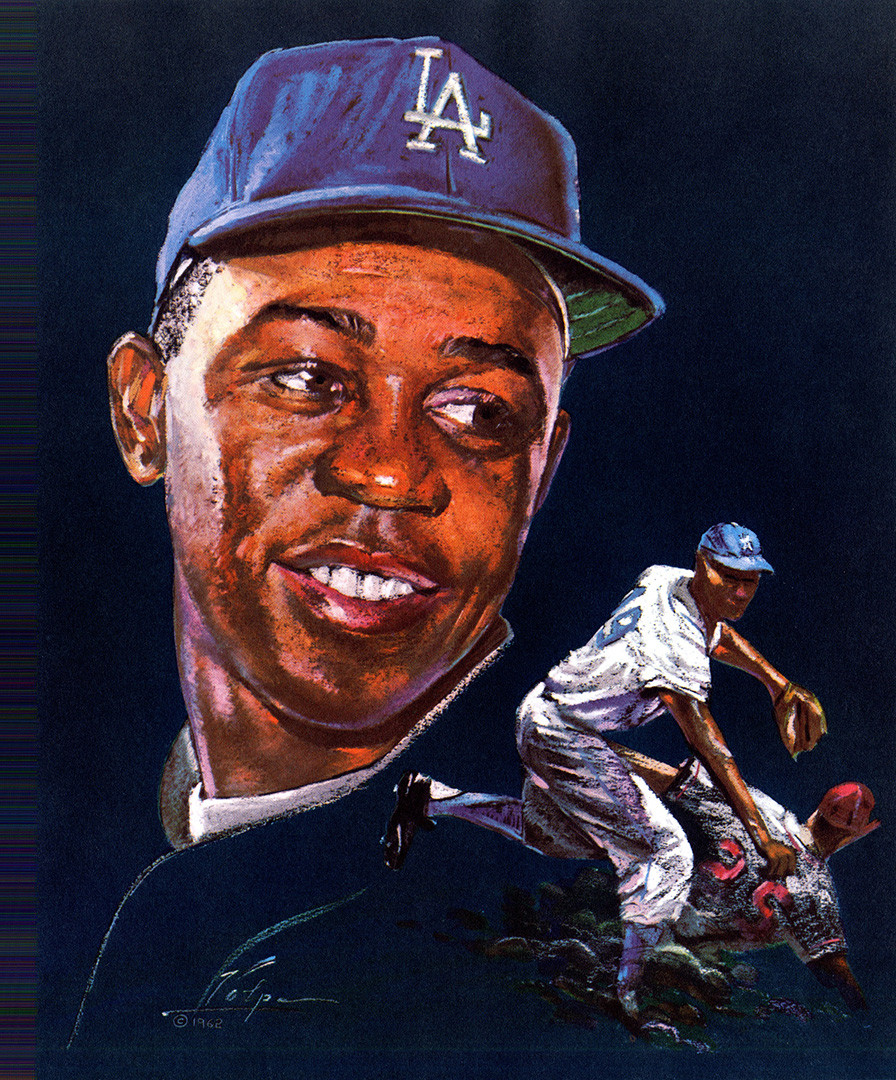
The team photo of the 1955 World Champion Brooklyn Dodgers at Dodgertown.
Feature
1955 Dodger World Championship is One for the Ages
By Brent Shyer
Immediately following the last out in a thrilling seven-game 1955 World Series, as the Brooklyn Dodgers stunned the New York Yankees, broadcaster Vin Scully said on air, “Ladies and gentlemen, the Brooklyn Dodgers are the Champions of the World!”
When fans later queried him how could he have remained so calm and why didn’t he say anything more than that, Scully added, “I couldn’t have said another word because I would have broken down and cried.”

Within seconds of the final out of Game 7 of the 1955 World Series, Dodger players and fans rush to the Yankee Stadium field and their joy erupts as the Dodgers had defeated the New York Yankees, 2-0. The Dodgers had won their first World Championship in their history on October 4, 1955. Dodger Manager Walter Alston is visible in the center wearing No. 24.
After years of frustration and the stigma attached to losing five previous World Series to the New York Yankees, their fierce cross-town rivals, the Dodgers finally redeemed themselves and became “second-class” citizens no more.
Next year had finally arrived for the Brooklyn Dodgers of 1955.

Johnny Podres, Dodger pitcher, 1953-1966. Podres is one of the great Dodger World Series pitchers in team history. He won four games through four World Championships in 1955, 1959, and 1963 and pitched for the 1965 World Championship Dodgers. Three of his four World Series wins are the day after a Dodger loss. It was his 2-0 shutout over the New York Yankees October 4, 1955 to give them their first World Championship. He is one of three Dodgers, along with Jim Gilliam, and Sandy Koufax, to play on four World Champion Dodger teams.
Artwork by Nicholas Volpe, 1962
Twenty-three year-old starting pitcher Johnny Podres is said to have declared to his teammates on the morning of Game 7 at Yankee Stadium, “Guys, just get me one run today.” The plucky and prophetic Podres got two runs to work with, as it turned out, but only need the one he had asked for, as he pitched a complete game eight-hitter to blank the Yankees, 2-0, on October 4, 1955.
For longsuffering Dodger fans, it doesn’t get any better than beating their perennial nemesis and their longtime magic carpet ride reached the apex. From the minute of the last out at 3:43 p.m., bedlam, block parties and wild celebrations carried on in Brooklyn through the night and into the early morning hours as revelers savored the sweetest moment in Dodger history – their first-ever World Championship in their 65-year history. Since their first appearance in 1916, the Dodgers had lost seven consecutive World Series.

Dodger President Walter O’Malley and pitcher Johnny Podres celebrate the team’s 2-0 Game 7 victory over the New York Yankees at Yankee Stadium in the visitor’s clubhouse. Podres pitched the shutout and holds artwork done on the spot by New York Post cartoonist John Pierotti to commemorate the World Championship.
It has been nearly 70 years since the Dodgers’ 1955 World Championship and the passage of time has taken its toll on this unforgettable team. Gone are the majority of the Dodger players who were such important members of the ballclub, including the entire infield of first baseman Gil Hodges, second baseman Jim Gilliam, shortstop Pee Wee Reese and third baseman Jackie Robinson. Legendary catcher Roy Campanella, who was the 1955 National League MVP, also passed away.
All of the starting outfielders have also passed, including Hall of Fame center fielder Duke Snider, left fielder Sandy Amoros and right fielder Carl Furillo. The pitching staff has also been diminished, as Joe Black, Roger Craig, Podres, Clem Labine, Billy Loes, Jim Hughes, Karl Spooner, Russ Meyer, Don Newcombe, Ed Roebuck, Don Bessent and Carl Erskine are departed, while Sandy Koufax cherishes his memories.
In addition, longtime Dodger Manager and Special Advisor to the Dodger Chairman Tommy Lasorda passed in 2021 at age 93. The left-hander pitched in four games in 1955. He later managed the Dodgers for 20 seasons, before Peter O’Malley immediately named him as a Dodger Vice President upon Lasorda’s 1996 retirement. Bob Borkowski, who played in nine regular-season games when Snider was injured, passed away November 18, 2017 at age 91. Two former teammates passed away in 2014; infielder Don Zimmer and outfielder George “Shotgun” Shuba.
Manager Walter Alston died on October 1, 1984, while then Dodger President Walter O’Malley passed away on August 9, 1979. For O’Malley and Alston, both in the Baseball Hall of Fame, it was the first of four titles they would celebrate together, as the Dodgers later garnered World Championships in 1959, 1963 and 1965.
Coaches Chuck Dressen, Jake Pitler, Billy Herman and Joe Becker all passed. O’Malley always gave credit to his two right-hand Vice Presidents – E.J. “Buzzie” Bavasi, in charge of player personnel and Fresco Thompson, who oversaw the Dodger farm system. Bavasi, who passed away in 2008 at age 93, was the architect for the Dodger teams that won three National League pennants in five seasons (1952, 1953 and 1955) and finished second in 1951 and 1954.
But, what of this team? Why did 1955 produce different results than in past meetings with the Yankees which resulted in five consecutive World Series losses – 1941, 1947, 1949, 1952 and 1953?

The team photo of the 1955 World Champion Brooklyn Dodgers at Ebbets Field. The Dodgers won their first World Championship in Brooklyn.

February 26, 1955
(L-R) Dodger right fielder Carl Furillo, Dodger Manager Walter Alston, Dodger President Walter O’Malley, Dodger first baseman Gil Hodges, and Dodger shortstop and captain Pee Wee Reese.
Dodger personnel point out the upcoming season in the Dodgertown clubhouse in Vero Beach, Florida. It would be a banner year for the Dodgers as they won the World Championship.
© Bettman/Corbis
For one reason, the talent-laden Dodgers answered April’s season-opening bell by winning their first 10 straight games. They then amassed a 22-2 mark by May 10 and never looked back. Right-handed pitchers Carl Erskine (five wins) and Don Newcombe (four wins) were responsible for nine of those 22 Dodger victories. Campanella won his third N.L. MVP crown with his stellar season, as he batted .318 with 32 home runs and 107 RBI. In MVP balloting, however, Campy was challenged by teammate Snider, finishing just five points ahead (226-221) while they each received eight first-place votes. Snider’s 136 RBI were tops in the National League, while his 42 home runs ranked fourth. The Dodgers led the N.L. in many offensive categories, including 201 home runs, 857 runs, .356 on-base percentage, 230 doubles and 674 walks.
Secondly, the Dodger pitching staff dominated the National League. The team’s 3.68 earned run average was best in the N.L. and the pitching staff combined for a league-best 773 strikeouts. Big “Newk” was clutch for the Dodgers, winning his first 10 in a row before suffering his first loss on June 12. He won 20 games that season, while hitting .359 with seven home runs, a National League record for pitchers. A wild but strong left-hander named Sandy Koufax, the 19-year-old “bonus baby,” pitched two scoreless innings in his June 24 debut.

Sandy Koufax, Dodger pitcher, 1954-1966. Koufax pitched for four World Series championship teams with the Dodgers in 1955, 1959, 1963, and 1965. Koufax won the 1963, 1965, and 1966 Cy Young Awards when there was only one award available for pitchers in both leagues. He won two games in the 1963 World Series and two games in the 1965 World Series and won the clinching games in 1963 and 1965 to be named the MVP in these two World Series.
Artwork by Nicholas Volpe, 1962
Another factor was second-year Manager Alston’s familiarity with his team and the National League, after the Dodgers’ second-place finish in his inaugural 1954 season. In 1955, the Dodgers won 98 and lost 55 in breezing to the N.L. Pennant by a whopping 13 ½ games over the second-place Milwaukee Braves (85-69). Meanwhile, over in the American League, the Yankees pulled away from Cleveland, Chicago and Boston in September to win the A.L. Pennant. The Yankees finished with a 96-58 record and edged the second-place Indians by three games and third-place White Sox by five games in the standings.
When the Dodgers defeated the Braves, 10-2 in Milwaukee’s County Stadium on September 8, they clinched the N.L. Pennant on the earliest date in league history, eclipsing their own 1953 mark. From August 27 to the day they captured the flag, the Dodgers caught fire, as they won 12 of 13 games. The Dodgers set a new record for “occupying or sharing the National League lead a total of 166 days out of the 168-day season.”1 The previous record was set by the New York Yankees who were in first place 164 out of 168 days. According to The Sporting News, “The only two days the Dodgers did not hold or share the lead were on April 11, when the Cubs won over the Reds in an early opening in Cincinnati, and on April 12, when the Brooks’ opener with Pittsburgh was delayed by one day because of rain.”2
In losing the first two World Series games at Yankee Stadium, the pattern which had been cut so many times before when the Dodgers fell to New York seemed to be repeating. The Yankees edged the Dodgers 6-5 in Game 1, as Joe Collins blasted two home runs. In Game 2, pitcher Tommy Byrne five-hit the Dodgers and also knocked in two runs in a four-run fourth to give the Yankees a 4-2 win.
When the scene shifted for Game 3 in Brooklyn, however, the Dodgers found more offense, as they had four two-run innings and won 8-3. Birthday boy Podres went the distance in Game 3, limiting the Yankees to seven hits. Campanella homered for the Dodgers, who pounded out 11 hits. The Dodgers evened the World Series in Game 4 with an 8-5 win. Campanella, Hodges and Snider drove in six of the eight runs and Labine earned the victory in relief.
The Dodgers reversal of fortunes continued in Game 5, as they powered their way to 5-3 victory at Ebbets Field. Cuban-born Sandy Amoros put the Dodgers ahead 2-0 in the second inning with a two-run home run, while Snider drilled solo round trippers in the third and fifth innings to make it 4-1. The two blasts by Snider made him the only player to hit four home runs in two different World Series (in 1952 and 1955), eclipsing a record previously shared with Babe Ruth and Lou Gehrig. Roger Craig picked up the win, with help from reliever Labine. Bob Cerv and Yogi Berra homered for the Yankees.

Duke Snider, Dodger outfielder, 1947-1962. Snider played on World Championship Dodger teams in 1955 and 1959. He is fourth on the all-time list in World Series home runs with 11. Snider was elected to the Hall of Fame in 1980.
Artwork by Nicholas Volpe, 1962
Snider stepped on a sprinkler head at Yankee Stadium and had to come out of Game 6. The Dodgers managed four hits and only one run in that game. The Yankees scored five first-inning runs, including three on a Bill Skowron home run, to take a commanding lead which Whitey Ford made stand up in the 5-1 win to even the Series.

A full ticket for the President’s Box at Ebbets Field for Game 5 of the 1955 World Series on October 2. Dodger President Walter O’Malley hosted family and guests in the box. The Dodgers defeated the Yankees, 5-3, before an Ebbets Field crowd of 36,796 fans to put them up in the Series, three games to two. Two days later, the Dodgers won their first World Championship
The shaping of Game 7 was purely fairy story material for the Dodgers. A crowd of 62,465 was in attendance at Yankee Stadium to root the Yankees on to a 17th World Series title. The Dodgers took a 1-0 lead in the top of the fourth inning on a RBI single by first baseman Hodges. He added a sacrifice fly in the top of the sixth inning to put the Dodgers in front 2-0 in support of Podres. Alston then tried to add to the Dodgers’ lead as he used pinch-hitter Shuba for second baseman Don Zimmer. But Shuba grounded out to end the top of the sixth. That fateful move, though, set up the defensive alignment that changed the game and the Series.

Jim Gilliam, Dodger player, 1953-1966. Gilliam is one of three Dodger players to play on four World Championship teams (1955, 1959, 1963, 1965) along with Sandy Koufax and Johnny Podres. In 1965, he made a game-saving play in Game 7 to preserve Sandy Koufax’ 2-0 shutout for a Dodger title. In 1964, he makes major league history by being named by the Dodgers to be the first Black coach on the baselines. His No. 19 was retired by the Dodgers in 1978.
Artwork by Nicholas Volpe, 1962
The Yankees put the tying runs on base in the bottom of the sixth inning. Alston had inserted Amoros to play left field as a defensive replacement. Gilliam, who had been playing in left field, moved to second base. With Gil McDougald on first and Billy Martin at second, catcher Yogi Berra hit a twisting drive to left which appeared to be a sure extra-base hit. The left-handed Amoros, running full speed towards the foul line and stands, extended his right arm and barely caught the ball in his glove like a snow cone. Amoros then had the presence of mind to throw the ball back to cutoff man Reese, who was standing down the line behind third base. Reese, in turn, fired the ball to Hodges at first base to nail McDougald and complete an amazing double play.

October 4, 1955 A dramatic photo from the left field stands provides a different look at the famous catch made by Sandy Amoros in Game 7 of the 1955 World Series at Yankee Stadium. Amoros made a fine running catch on a fly ball hit by Yogi Berra just inside the left field line in the sixth inning. In the background, Dodger shortstop Pee Wee Reese begins moving to the third base line to receive a throw from Amoros and Reese then relayed to first baseman Gil Hodges for the double play to stop the Yankee rally. The play saved the game, and Johnny Podres stopped the Yankees the rest of the way for the first Brooklyn Dodgers’ World Championship.
That one play took the life out of the Yankees, while Dodger fans started believing that this could finally be their moment of glory. Confidences soaring, Podres remained calm and cool on the mound in the final three innings.
The historic final out was recorded when Elston Howard grounded to Dodger shortstop and team captain Reese. Although Reese threw the ball somewhat low and wide, steady first baseman Hodges, who had the largest hands on the club, was not going to miss the catch no matter where the ball was headed. He didn’t and the Dodger celebration began. It was fitting that Reese, who had played in five previous World Series against the Yankees beginning in 1941, successfully made the last play.
It was the first time a team had lost the first two games and come back to win a seven-game Series. Thirty Dodgers each received a full-share of $9,768.21 for winning the World Championship. Jim Hughes, who was with the club earlier in the year, received a half share. Pitcher Lasorda, who was optioned on June 8 to make room for another left-handed hurler named Koufax, received a cash award of $1,000 for his four games. Outfielder Bob Borkowski (9 games) and pitcher Pete Wojey (never appeared but was on the roster) received lesser awards.

Jubilation in the Dodger clubhouse as Walter O’Malley and second-year Manager Walter Alston embrace as the Dodgers win their first World Championship on Oct. 4, 1955. The Dodgers defeated the New York Yankees, four games to three, with a 2-0 clincher in the seventh game at Yankee Stadium.
Alston, 43, was named National League Manager of the Year by members of the Baseball Writers Association of America. He forever earned a special place in the hearts of Dodger fans by winning the World Series. “I’m the same manager,” the strong but quiet skipper proclaimed. “I didn’t run the club any differently this year than last year. Injuries hurt us in 1954, breaks helped us in 1955.”3
One columnist in The Sporting News was more generous in his opinion about Alston’s performance in 1955. “The Dodgers are not the easiest club to handle; they are filled with varied temperaments, but Alston kept them all in check. His work through the season and in this (World) Series cannot be underestimated. He knew his men. Those who could, got the chance to deliver for him. Those who were reluctant were discarded. In the final game, with everything at stake and a bullpen full of candidates, he could have replaced Podres. But here he didn’t change. Here he stayed with his man and the payoff was terrific.
“When Alston was hired two years ago, it was because Walter O’Malley believed he could guide the Dodgers not only to a pennant, but to a World’s Series championship. O’Malley’s confidence in his man was repaid in the final game of the Series. For this victory, Alston deserves as much credit as Podres and all the rest.”4
By mid-November, O’Malley and the Dodgers had received congratulatory letters and telegrams from 26 foreign nations, including King Faisal II of Iraq, who had visited Ebbets Field for his first baseball game in 1952 at the age of 17. The young monarch wrote, “Happy to know of your great success in the World Series. Wish you always well.” O’Malley earned the plaudits of baseball as he was named 1955 Major League Executive of the Year by The Sporting News in its January 4, 1956 cover story.
This was the Brooklyn’s finest hour and the pinnacle of success.
Hall of Fame broadcaster Scully, who retired after his 67th season with the Dodgers in 2016, once recalled: “In 1955, when the Dodgers won their only championship for Brooklyn, that was more than just a World Series victory. It was a crowning point for a Borough that had given its heart to the ballclub and had been disappointed so many times. I can remember when that game ended in Yankee Stadium. Suddenly, the Bronx was in a football mode. Fall had arrived. And we went through the Battery Tunnel and came out on the Brooklyn side and hallelujah it was like VE Day and VJ Day! I mean there was dancing in the streets, block parties, stores were closed. That really stays in your mind and in your heart as well.”5

